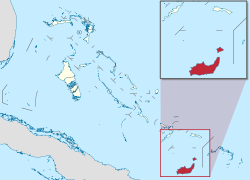Great Inagua
| District of Inagua | ||
|---|---|---|
| District | ||
|
||
 |
||
| Country |
|
|
| Island | Great Inagua | |
| Established | 1800 | |
| Government | ||
| • Type | District Councils | |
| • Sr. Chief Councillor | Ronald Roker | |
| • Jr.Deputy Chief Councillor | Nirel Moultrie | |
| • Jr.Treasurer | Perontay Fawkes | |
| Area | ||
| • Total | 1,679 km2 (648 sq mi) | |
| Population (2010) | ||
| • Total | 913 | |
| • Density | 0.54/km2 (1.4/sq mi) | |
| Time zone | EST (UTC−5) | |
| • Summer (DST) | EDT (UTC−4) | |
| Area code(s) | 242 | |
Inagua is the southernmost district of the Bahamas, comprising the islands of Great Inagua and Little Inagua. The headquarters for the district council are in Matthew Town.
The original settler name Heneagua was derived from a Spanish expression meaning 'water is to be found there'. Two names of apparent Lucayan origin, Inagua (meaning "Small Eastern Island") and Baneque (meaning "Big Water Island") were used by the Spanish to refer to Great Inagua.
Several documented treasure laden ships were destroyed on Inaguan reefs between the years of 1500 and 1825. The two most valuable wrecks lost off the Inaguas were treasure-laden Spanish galleons: the Santa Rosa (1599) and the Infanta (1788). Other ships of considerable value were the British HMS Statira in 1815, the HMS Lowestoffe in 1802, and the French Le Count De Paix in 1713.
Local legend has it that Henri Christophe, King of Haiti from 1811 to 1820, buried treasure at the Northeast Point of Great Inagua where he had a summer retreat.
In the 1930s the Erickson brothers developed the Great Inagua saltworks. In the mid-1950s Morton Salt bought the Great Inagua saltworks, which includes over eighty salt ponds, and is the second largest such operation in North America. Morton's is the major employer on the island.
Great Inagua is the second largest island in the Bahamas at 596 sq mi (1544 km2) and lies about 55 miles (89 kilometres) from the eastern tip of Cuba. The island is about 55 by 19 mi (89 by 31 km) in extent, the highest point being 108 ft (33 m) on East Hill. It encloses several lakes, most notably the 12-mile (19 km) long Lake Windsor (also called Lake Rosa) which occupies nearly a quarter of the interior. The population of Great Inagua is 913 (2010 census).
...
Wikipedia

